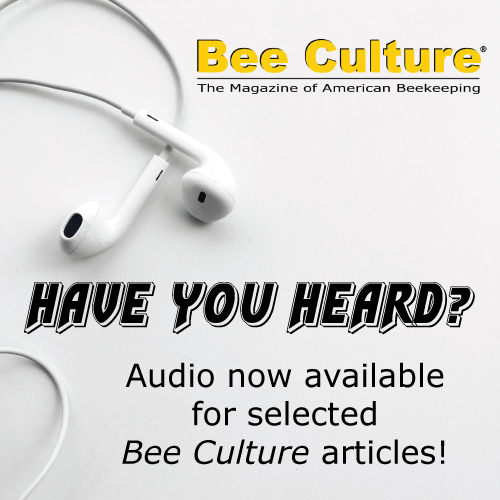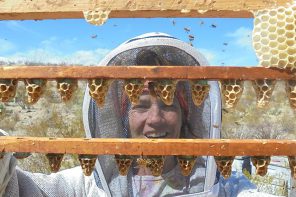Click Here if you listened. We’re trying to gauge interest so only one question is required; however, there is a spot for feedback!
Read along below!
Found in Translation
I’ve just gotta bee me!
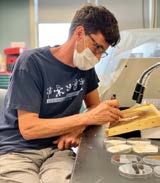 By: Jay Evans, USDA Beltsville Bee Lab
By: Jay Evans, USDA Beltsville Bee Lab
Picture peeping into an observation hive or simply watching a pulled frame of calm worker bees. You will soon notice a range of different acts by the bees in your view. Some might be burrowed into cells, some will be engaged in intimate conversations with nestmates, some will be carrying hive debris and some will be doing a happy dance after bringing back pollen or nectar. It has been known for decades that worker bees advance through different tasks as they mature. The primary shift is from ‘nursing’ or nest behaviors while bees are young, to foraging behaviors as they grow older. Young bees produce a nutritious processed food that they use to provision brood, and younger bees also produce the wax needed for hive partitions. Older bees, typically around two weeks old, start a life of foraging when outside conditions permit. If you want to read more about life’s big changes among social insect workers, including this switch from indoor to outdoor tasks, read the review article Regulation Of Division Of Labor In Insect Societies by Professor Gene Robinson (https://www.researchgate.net/profile/Gene-Robinson/publication/21615667_Regulation_Of_Division_Of_Labor_In_Insect_Societies/links/5738cf9a08ae9f741b2bd8a1/Regulation-Of-Division-Of-Labor-In-Insect-Societies.pdf), a review which has held up well since being published 30 years ago.
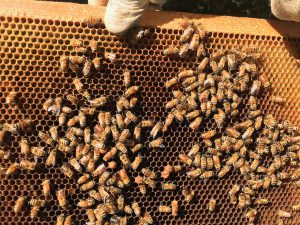 But these major transitions are not the whole story. Gazing into our lab’s observation hive makes me think of the picture books by Richard Scarry I read while young (you can’t go wrong with his book What do people do all day?). In these books, everyone is shown doing a specific trade, reflecting the many workers needed to make societies function. Bees are onto that as well, by specializing to some extent on certain hive roles. The specialization is subtle in the face of typical life transitions. Most bees, if they live long enough, will fly from the hive as they mature and initiate foraging. Similarly, most young bees will do some nursing. But there are deviations from this path. Some bees are known to be ‘precocious’ foragers, perhaps reflecting a stress faced earlier in their lives or perhaps reflecting their particular genetics. While foraging, some bees might prefer pollen to nectar on their floral trips, while others might tend to favor resins from plants, or water. In the nest, some bees are better linked into the social web than others and some might linger on particular observable tasks. In short, a bee is a bee; a replaceable but non-identical part of the whole colony.
But these major transitions are not the whole story. Gazing into our lab’s observation hive makes me think of the picture books by Richard Scarry I read while young (you can’t go wrong with his book What do people do all day?). In these books, everyone is shown doing a specific trade, reflecting the many workers needed to make societies function. Bees are onto that as well, by specializing to some extent on certain hive roles. The specialization is subtle in the face of typical life transitions. Most bees, if they live long enough, will fly from the hive as they mature and initiate foraging. Similarly, most young bees will do some nursing. But there are deviations from this path. Some bees are known to be ‘precocious’ foragers, perhaps reflecting a stress faced earlier in their lives or perhaps reflecting their particular genetics. While foraging, some bees might prefer pollen to nectar on their floral trips, while others might tend to favor resins from plants, or water. In the nest, some bees are better linked into the social web than others and some might linger on particular observable tasks. In short, a bee is a bee; a replaceable but non-identical part of the whole colony.
Recent technical advances allow researchers to both measure and analyze the behaviors of bees throughout their lifespans and in a social setting. Numbered tags, similar to those put on some queens, have been used to keep track of individual worker bees for decades. Newer tags are both more ‘apparent’ to hive sensors and have a far greater level of discrimination, allowing hundreds or thousands of bees to be followed at once. Professor Robinson’s group has deployed this technology to tackle bee health issues ranging from the impacts of infection and chemical stress on bee behavior to a better understanding of the underlying neurodiversity of bees and how this diversity is driven by age and genetics. One example of this line of work comes from a paper with Tim Gernat as lead author (Gernat T, Rao VD, Middendorf M, Dankowicz H, Goldenfeld N, Robinson GE (2018) Automated monitoring of behavior reveals bursty interaction patterns and rapid spreading dynamics in honeybee social networks Proc Natl Acad Sci 115:1433–1438. doi:10.1073/pnas.1713568115). My favorite insight from this paper was that bees did not inherently recognize each other as individuals, and therefore bee-to-bee feeding was driven by chance encounters and immediate cues, rather than some shared memory of prior encounters. The paper is highly technical, in part because the authors want the results to be general to all society interactions, including our own. It is also impossible to analyze so many interactions without classifying each encounter in a strict mathematical way.
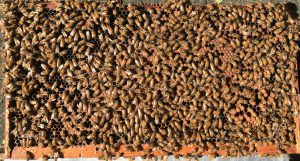 If that paper catches your interest, you will also enjoy an upcoming paper that tackles individual bee biases (‘personality’ is probably too strong of a word) that can last throughout their lifetimes. This paper, led by Michael Smith from Auburn University (Smith, M. L., Davidson, J. D., Wild, B., Dormagen, D. M., Landgraf, T., & Couzin, I. D. (2022) Behavioral variation across the days and lives of honey bees. iScience, 104842. https://doi.org/10.1016/j.isci.2022.104842) ups the bee-tracking challenge by following over 4,000 nestmates as they do their nest duties over an entire Summer. The results are complex and could be scrutinized for months, but there are some interesting guilds or ‘clusters’ of bees that seem to be on more similar paths than the paths of others. These paths involve the aforementioned age-biased tendencies to leave the nest and fly. Within that split, some groups of bees might be more prone to navigate widely in the nest than others, or to be found hovering around honey stores. And I especially resonated with ‘day cluster 4’ (“behavioral days associated with middle-aged bees, with metrics representing slow, localized behavior”). That sounds a lot like the past two years for me.
If that paper catches your interest, you will also enjoy an upcoming paper that tackles individual bee biases (‘personality’ is probably too strong of a word) that can last throughout their lifetimes. This paper, led by Michael Smith from Auburn University (Smith, M. L., Davidson, J. D., Wild, B., Dormagen, D. M., Landgraf, T., & Couzin, I. D. (2022) Behavioral variation across the days and lives of honey bees. iScience, 104842. https://doi.org/10.1016/j.isci.2022.104842) ups the bee-tracking challenge by following over 4,000 nestmates as they do their nest duties over an entire Summer. The results are complex and could be scrutinized for months, but there are some interesting guilds or ‘clusters’ of bees that seem to be on more similar paths than the paths of others. These paths involve the aforementioned age-biased tendencies to leave the nest and fly. Within that split, some groups of bees might be more prone to navigate widely in the nest than others, or to be found hovering around honey stores. And I especially resonated with ‘day cluster 4’ (“behavioral days associated with middle-aged bees, with metrics representing slow, localized behavior”). That sounds a lot like the past two years for me.
When one looks at the ‘lifetime achievement’ of individual bees, there are bees that moved to foraging earlier than others (and died younger) but also bees that tended to be more mobile in the nest, and show traits that set them apart from other nestmate groups. In short, whether defined by five clusters (as in this study for bee-days and bee-lives) or three or 20 clusters, there is solid evidence that bees don’t all follow the same life journey. It will be fascinating to connect these behavioral quirks with bee genetics (reflecting the dozens of possible paternal lineages in each colony), pesticide exposure, or maybe just a chance encounter of some sort earlier in life that has long-term impacts on bee lives. Honey bees have faced a lot of scrutiny by beekeepers and scientists, but one of the last frontiers is to see how individual members of the colony superorganism deviate enough from the lockstep of colony life to make things perhaps a bit more stable, if not more efficient. It takes a colony to raise a bee, but that bee then has some flexibility in her choices as she navigates cues and events both within and outside her home.




